2019-12-19 15:43:32 0
Communications World Network News (CWW) Recently, the State Grid (State Grid) Company plans to use China Radio and Television's 700MHz frequency band and 60MHz spectrum resources to carry out 5G network construction news spread like wildfire, and the "State Grid 5G Network Construction Plan" was also immediately exposed. It is reported that the 5G network construction content of State Grid is divided into six parts: core network construction, bearer network construction, base station construction, network management and support system construction, security system construction, and self-use business terminal construction for service company production and operation.
The specific contents of the plan are as follows:
State Grid (State Grid) Company plans to use China Radio and Television's 700MHz frequency band and 60MHz spectrum resources to carry out 5G network construction. The 5G network construction content is divided into six parts: core network construction, bearer network construction, base station construction, network management and support system construction, security system construction, and self-use business terminal construction for the production and operation of service companies.
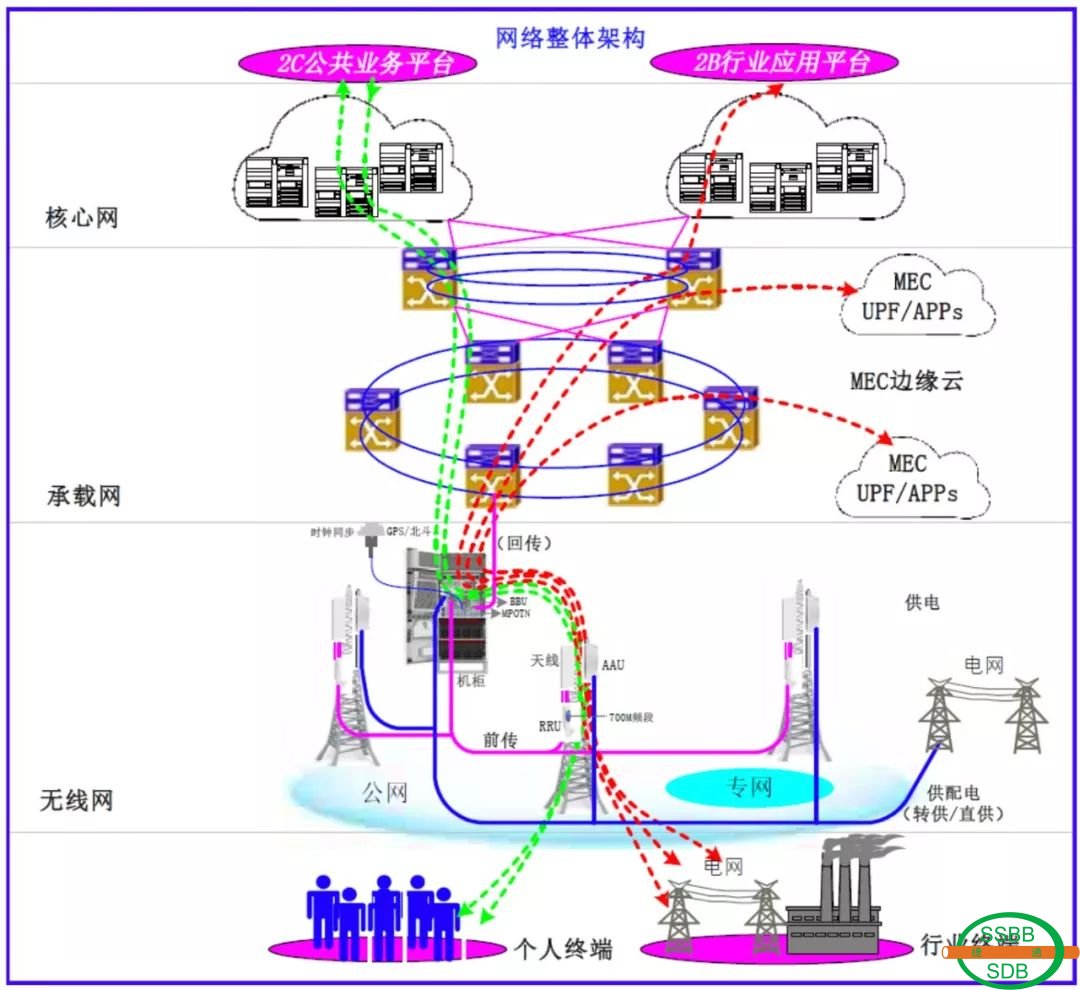
State Grid 5G network overall architecture diagram
Core Network
The 5G core network construction of State Grid Corporation is oriented to business needs, and builds four network levels: national level, regional level, provincial level, and prefecture level. Two sets of backbone NRF (Network Repository Function) are set up at the national level, 6 core network control plane network elements are set up at the regional level, 27 core network user plane network elements are deployed at the provincial level, and 294 are deployed at the municipal level Core network user plane network element.
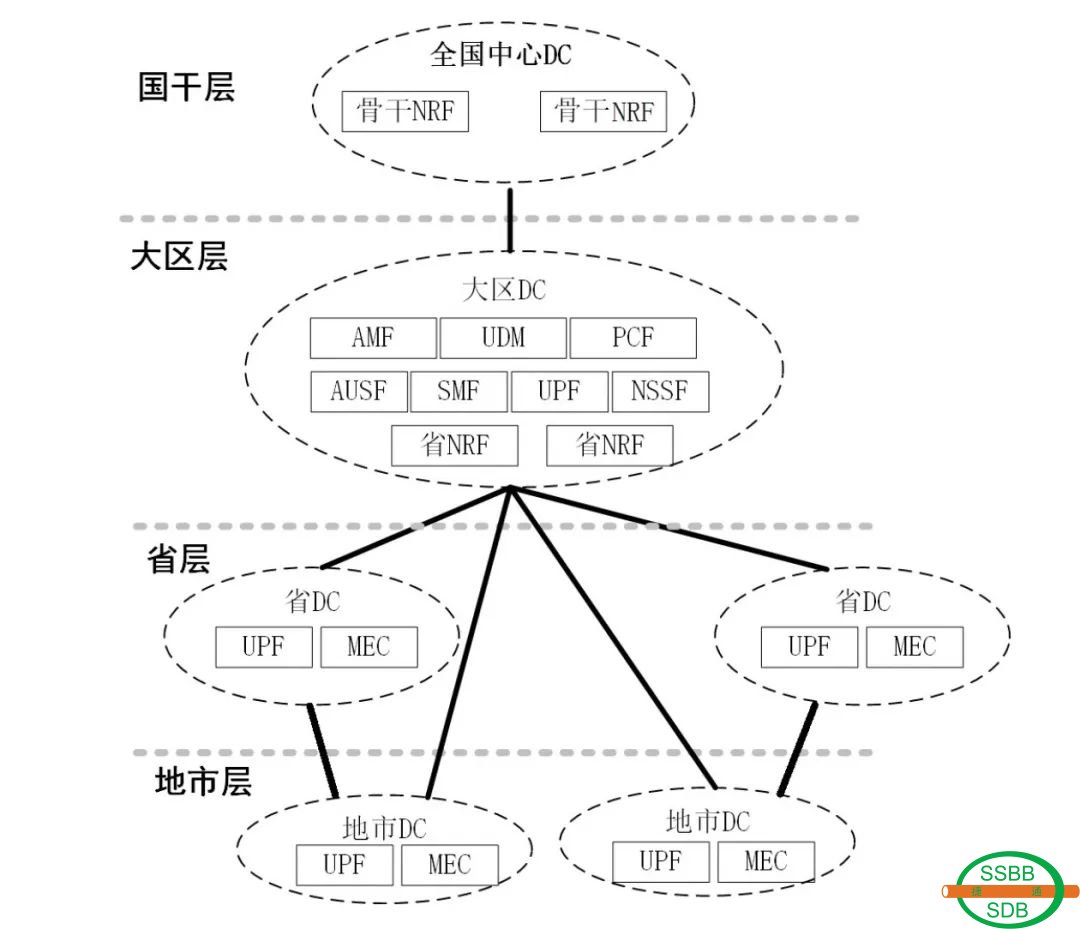
5GC network architecture diagram of hierarchical deployment
The national trunk layer is deployed in two central cities, responsible for the registration, discovery and selection of network functions, and opening up 5G network capabilities to the outside world.
The regional layer is deployed in the 6 branches of the State Grid Corporation, which mainly implements the core network control plane function and is responsible for terminal mobility and access management; SMF (session management function) is responsible for dialogue management functions, etc.
The provincial level is deployed in 27 provincial companies of State Grid Corporation, and the prefecture level is deployed in 294 prefectural and municipal companies. Both of them mainly implement core network user plane functions and are responsible for data aggregation, wireless links, and media access.
Bearer network
State Grid's 5G bearer network mainly relies on the company's existing resources and is divided into three parts: inter-provincial trunk lines, intra-provincial trunk lines, and local networks.
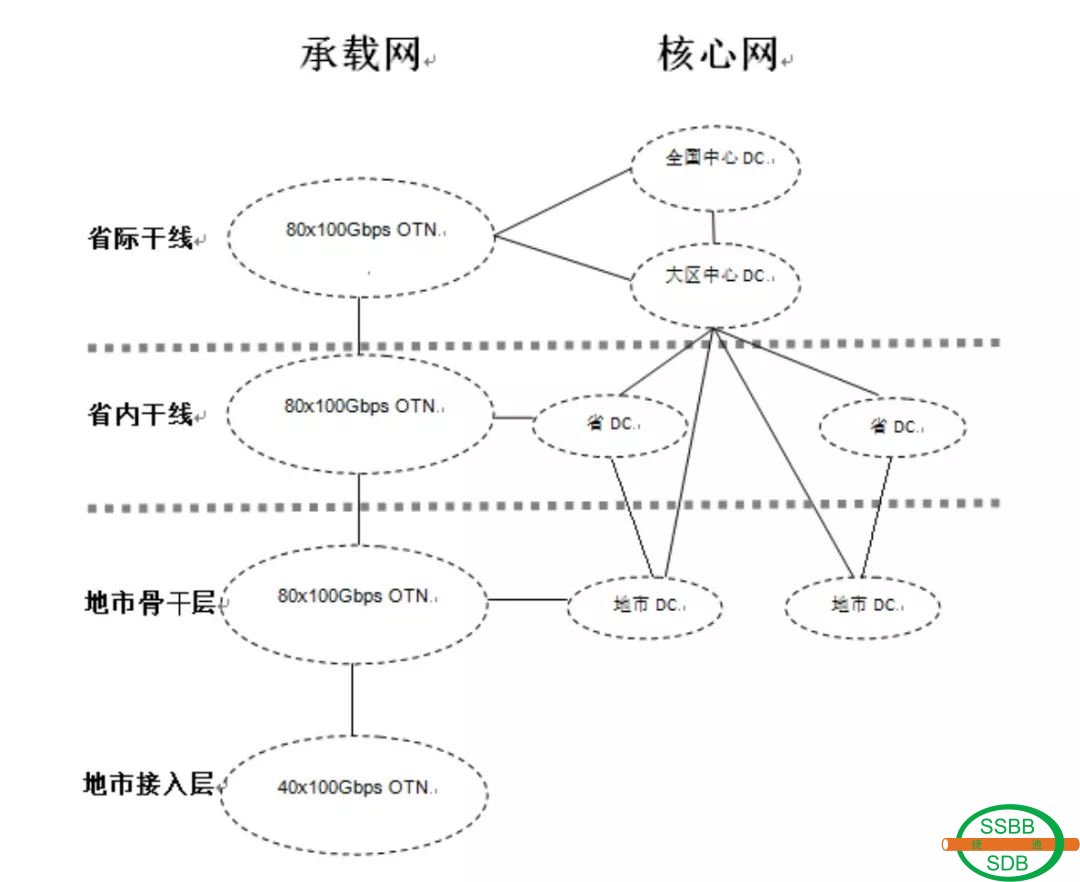
Correspondence between bearer network and core network
Inter-provincial route
The inter-provincial trunk line carries the national cross-provincial business, connecting the national center, the regional center and the provincial center, and realizes the data exchange among the provincial core, the regional core, and the national core. The inter-provincial transmission network is built with OTN equipment, with a single transmission capacity of 80x100Gbps. All equipment is installed in the head office, the central computer room of the provincial company, and the communication computer room of the substation above 500kV.
At present, the State Grid Corporation's inter-provincial trunk optical cables are mainly OPGW optical cables, which are installed with power grid lines of 500 kV and above. At present, the construction time of inter-regional and inter-province optical cables is relatively early, the number of optical fiber cores is relatively small, and the carrying system is relatively large, and the resource utilization rate is high. Some sections of optical cable resources have bottlenecks. Inter-provincial trunk lines give priority to the use of vacant fiber cores of existing optical cables, and at the same time vacate and integrate existing network equipment. Some sections of the optical cables are modified according to actual needs.
Provincial Route
The provincial optical transmission system is a three-level backbone optical transmission network of the State Grid, which carries the services of various provinces and cities, connects the provincial center with the city center, and realizes the upload and delivery of services between the core network of each city and the provincial core network. The provincial optical transmission system adopts OTN equipment networking, and the network capacity is 80x100Gbps. All equipment is installed in provincial companies, prefectural and municipal companies, and communication rooms of 220kV and above.
At present, the main optical cables in the province are OPGW optical cables. With the erection of power grid lines of 220 kV and above, some sections of optical cable resources have bottlenecks, and new optical cables need to be built.
Local network
The local network is a bearer network that connects the prefecture and city base stations to the prefecture and city 5G core network, and is divided into the prefecture and city access layer and the prefecture and city backbone layer.
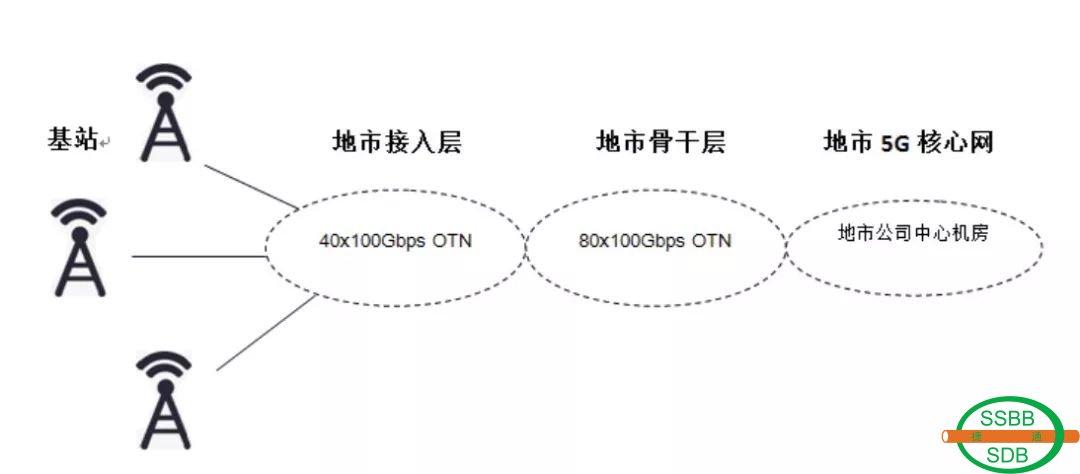
Local network service delivery structure
The backbone layer of the prefecture and city plays a convergent role in the local network, and the services uploaded by the 5G base station uploaded by the access layer of the prefecture and city are transmitted back to the city 5G core network. The transmission network of the prefecture and city backbone layer is the four-level backbone network of the State Grid, which realizes the convergence of the access layer services of prefecture and city. A single device is designed according to the convergence of 6 access layer devices, using 80x100Gbps capacity OTN equipment, and the installation location is the 110kV station computer room, the county company computer room is mainly the self-owned property.
Uplink optical cables on the backbone layer of prefectures and cities rely on 110kV and 35kV line optical cables of prefectures, and some sections need to be supplemented by new optical cables. At present, most of the 110kV station computer rooms use integrated power supplies, which are difficult to meet the power access requirements of new equipment, and involve a large amount of power supply transformation. Some equipment rooms are in poor condition and do not meet the equipment operating environment and need to be modified.
The prefecture and city access layer, as the end layer of the bearer network, is generally a ring network structure, which connects the 5G base station with the prefecture and city backbone layer to upload 5G services to the prefecture and city core network. The transmission network of the prefecture and city access layer realizes 5G base station access. A single device is designed to access 8 base stations. The equipment has a wide coverage, a large number, and a large bandwidth demand. It uses 40x100Gbps capacity OTN equipment.
The degree of overlap between the optical cables of the prefecture and city access layer and the existing network optical cables is not high, and the optical cables of the prefecture and city access layer down to the 5G base station and uplink to the convergence layer of the city need to be newly built. The optical transmission equipment installation site of the prefecture and city access layer preferentially select self-owned properties such as substations, power distribution stations, and business halls, and third-party properties are selected for some site locations. The power supply used at the site site cannot meet the demand for new equipment, and most sites require power supply transformation.
Wireless access network
The construction of the wireless access network uses SA (Standalone: independent networking) as the basic structure, with the goal of building a cooperative wireless structured network of “layout layer, blind-filling layer, and heat absorption layer” to fully utilize existing towers, Supporting resources such as computer rooms, newly built 113,100 base stations, and improved supporting power facilities. The wireless network will cover 650,000 square kilometers of Class A+, A, B, and C areas within the company's business area, as well as some areas of Class D, including more than 60% of the population in the business area of State Grid.
In terms of site selection for 5G base stations, make full use of the company's rich infrastructure resources and facilities, and choose self-owned towers and stations (power companies, substations, power supply stations, business halls, etc.) as much as possible. Later, according to the network coverage, replacement can be considered to be rented Tower of the Iron Tower Company.
In terms of the construction of poles and towers, according to the type of site resources, the construction content mainly includes:
(1)Self-owned property station: construct various roof heightening frames, roof masts/holding poles on the roof of self-owned property buildings, or build self-supporting iron towers to add base station antennas and install outdoor equipment.
(2)Self-owned property towers: install iron tower poles on power transmission towers to add base station antennas and install outdoor equipment.
(3)Renting third-party towers and stations such as iron tower companies: install poles on third-party communication towers to add base station antennas and install outdoor equipment.
In terms of computer room construction, it is mainly divided into two types: fixed building computer room and outdoor mobile computer room.
For self-owned property sites, under normal circumstances, the base station equipment is installed in the communication room or the secondary equipment room. When the screen space or the room area is insufficient, it needs to be expanded or reformed; some power supply stations and business halls without a computer room need to be built.
The outdoor activity machine room is used for owning power poles and renting third-party resource sites. It is deployed in its own power pole tower site, mainly including two methods, one is to arrange a compact machine room inside the angle steel tower or steel tube tower with voltage level of 110kV and above, the effective use area is about 6m2; the other is the angle steel with voltage level below 110kV For the tower and steel pipe poles of various voltage levels, it is recommended to arrange the mobile equipment room outside the tower and take necessary lightning protection measures.
In terms of power supply, for power supply companies, substations, power supply stations, business halls and other self-owned property sites, due to the new base station equipment, the power load demand increases, and the power capacity of some sites is insufficient, and the power supply needs to be expanded or modified; the above-mentioned self-owned properties Newly-built computer rooms and new outdoor mobile computer rooms shall be equipped with -48V power supply system in accordance with technical standards.
In terms of fronthaul networks, for both self-owned property sites and self-owned property towers, the existing power fiber optic cable resources can be used. Some power supply stations and business halls do not have local access to fiber optic cable resources or insufficient fiber core capacity. , It is necessary to build a new fronthaul optical cable; if you rent a third-party tower or station such as a tower company, you need to rent or build a new fronthaul optical cable depending on the specific situation.
Network Management System
Based on core network deployment, State Grid Corporation builds a network management system hierarchically. The construction content includes integrated network management system, terminal network management system, wireless network operation support system, wireless network operation and maintenance support system and synchronized clock.
Facing the newly-built 5G network, the challenges of network management, operation, and operation and maintenance will be comprehensive. Automated and intelligent network operation and maintenance capabilities will become a rigid demand for telecom network operation and maintenance in the 5G era. Through the application of artificial intelligence, big data analysis and other technologies, it can realize high-computational data analysis, cross-domain feature mining, dynamic strategy generation, etc., and build a series of platforms and systems such as integrated network management systems, operation support systems, and operation and maintenance support systems. Give new models and capabilities for network management, operation, and operation and maintenance in the 5G era.
Management support platform architecture security system
The construction of State Grid's 5G network security system is based on the overall network deployment and service access planning. Focus on building network security construction covering the isolation protection of the company’s private network and the 5G public network, and the security protection of the 5G network itself; carry out the access protection and security monitoring construction of massive IoT terminals to ensure border security and terminal security; according to business Different types, carry out targeted security protection design and construction to ensure business safety.
Isolation and protection of 5G private network and 5G public network
According to its own business needs, the company reserves a dedicated channel to carry special power services in the 5G network to achieve physical isolation from the 5G public network to meet national and industry regulatory requirements. The specific plans are as follows:
In terms of terminals, power dedicated services and 5G public network services use different terminals; in terms of air interface, power dedicated services and 5G public network services use different fixed frequency spectrums to achieve physical isolation; in terms of base stations, power dedicated services and 5G public network services are different The RRU is connected to different BBU baseband boards, sharing common boards and chassis such as BBU control and power supply; for the backhaul network, the time slot isolation method is adopted through the power backhaul network to achieve physical isolation; for the core network, the power business is passed through the company Core network transmission, public network services are transmitted through the radio and television core network to achieve physical isolation. The schematic diagram of isolation protection is as follows:
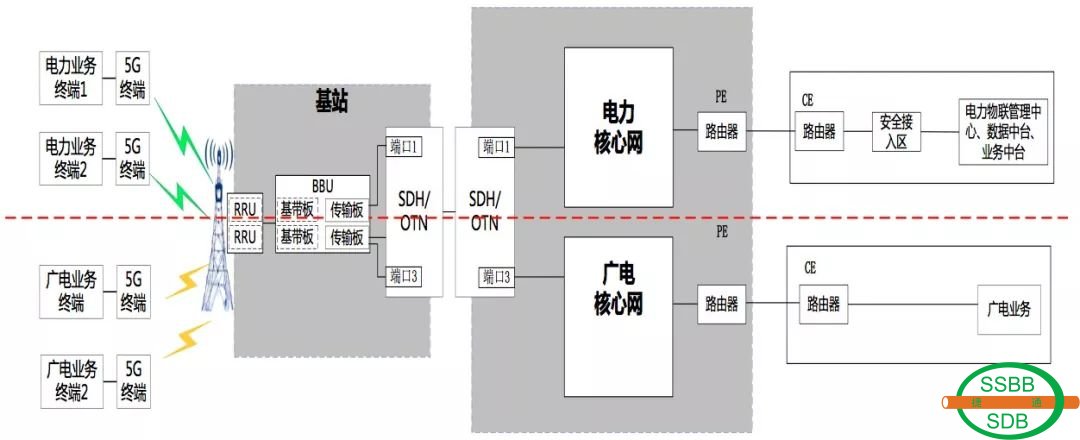
5G network security protection
Build systematic and differentiated security protection capabilities for 5G networks, and realize user data security as the center. In the complete life cycle of data from generation to transmission to the terminal, not only pay attention to the security protection of 5G itself, but also target the cloud and terminal And so on for systematic and complete protection. Build reliable differentiated security protection capabilities to ensure that 5G networks provide differentiated security protection services for different users and different businesses.
Build a unified end-to-end identity authentication system to achieve a unified authentication chain and an authoritative digital identity system. From the terminal to the cloud to the operator network to the base station, complete identity authentication is performed to filter out most illegal users and illegal users. Intrusion and prevent the spread of Trojan horses.
Establish security protection measures for edge computing to ensure the terminal physical security, cloud platform security, data security, and communication security of the power business system.
Establish a network slicing security protection mechanism to ensure network slicing security through wireless access network isolation, bearer isolation, isolation between network slicing, network function isolation, network slicing and user isolation, and other security measures to prevent illegal access between network slicing.
Border and terminal security
Carry out the access protection and security monitoring construction of massive IoT terminals. Through the construction of eSIM security chips and security modules, measures such as credible reinforcement and authentication are adopted to solve various security problems such as terminal forgery and access. Carry out the confidentiality and integrity protection of signaling data and user plane data, and realize two-way authentication between wireless communication terminals and base stations.
Business application security
According to different types of 5G network bearer services, analyze typical security risks and requirements, and carry out targeted security protection design and construction work:
For eMBB (enhanced mobile broadband) scenarios with extremely high bandwidth requirements, such as ultra-definition video surveillance, mobile inspections, etc., 5G networks can extend LTE security mechanisms to meet the security requirements of eMBB scenarios.
For mMTC (Massive Machines) with higher link density requirements, such as smart home and electricity information collection services, lightweight security algorithms and simple and efficient security protocols are designed to reduce the authentication and identity management of IoT devices. Cost, to achieve high-efficiency security protection for mass devices of the ubiquitous power Internet of Things.
For low-latency and high-reliability uRLLC (ultra-reliable low-latency) scenarios, such as distribution automation, distribution network differential protection, etc., by reducing the need to optimize the service access process identity authentication delay and data transmission security protection The time delay caused by the terminal movement process due to security context switching, and the time delay caused by data encryption and decryption processing in the network node.
Business and terminal
State Grid Corporation purchased some of its own business terminals while building 5G networks to carry out business access work. The main types of early access services include distribution automation, electricity consumption information collection, precise load control, distribution transformer monitoring, and distributed energy.
State Grid's 5G network operation is mainly for 2B and 2C customers. The 2B business can be divided into company-owned businesses (such as power distribution automation, electricity consumption information collection, etc.) and other industries (enterprise) user businesses.
With reference to the experience of public network operation and management, operators are not responsible for the procurement and construction of terminals, but are handled by business users themselves, such as personal mobile phones, corporate terminal CPE (customer pre-equipment), etc., so the terminal part of the State Grid 5G network construction is mainly To serve the construction of self-use business terminals produced and operated by the company, the main business types include power distribution automation, electricity consumption information collection, precise load control, distribution monitoring, distributed energy, etc.
The current power business access to the wireless network is mainly achieved through independent CPE terminal access. With the large-scale construction of the network and the large-scale terminal access, the external independent CPE terminal cannot meet the needs of construction and operation and maintenance. The modular communication warehouse will be a reasonable solution. For example, the 5G communication warehouse of the 700MHz frequency band is used in the meter concentrator to replace the existing 4G communication warehouse of the operator, and the sim card of the company's 5G network can be inserted into the network.
The following figure shows two different terminal forms taking marketing business as an example.

Talent team building
It is recommended to take the 5G network construction as an opportunity to continue to carry out 5G technical training and continuously cultivate expert and compound talents. At the same time, communication agencies at all levels are allowed to try to use more flexible employment methods (such as: labor dispatch, business outsourcing, etc.), so as to realize the rapid expansion of wireless network construction talents. After the completion of the 5G network, the talent team participating in the construction can be transferred to network operation and maintenance personnel, thereby establishing a long-term and stable construction control and operation and maintenance management team.





